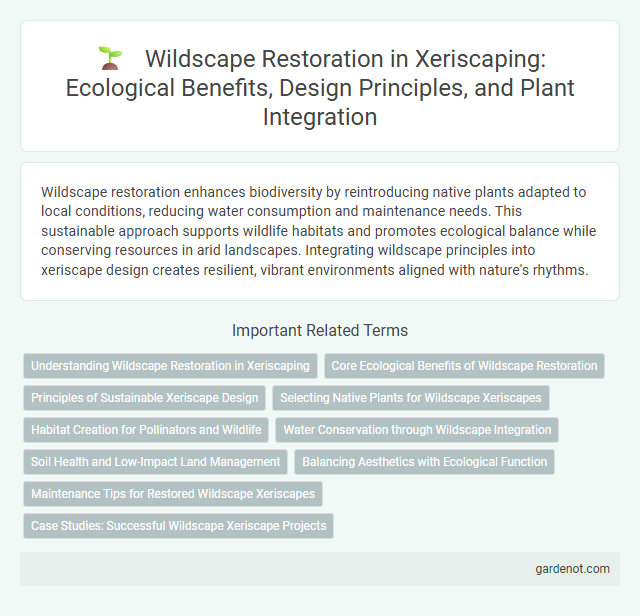Wildscape restoration enhances biodiversity by reintroducing native plants adapted to local conditions, reducing water consumption and maintenance needs. This sustainable approach supports wildlife habitats and promotes ecological balance while conserving resources in arid landscapes. Integrating wildscape principles into xeriscape design creates resilient, vibrant environments aligned with nature's rhythms.
Understanding Wildscape Restoration in Xeriscaping
Wildscape restoration in xeriscaping involves reintroducing native plant species and reconstructing natural habitats to promote biodiversity while conserving water resources. Emphasizing drought-resistant flora such as cacti, grasses, and wildflowers enhances ecosystem resilience and reduces irrigation demands. This sustainable landscaping technique supports local wildlife, stabilizes soil, and mitigates urban heat effects by maintaining natural ecological balance.
Core Ecological Benefits of Wildscape Restoration
Wildscape restoration enhances biodiversity by reestablishing native plant species that provide essential habitat and food sources for local wildlife, promoting ecological balance and resilience. It improves soil health through natural processes like nitrogen fixation and organic matter accumulation, leading to more sustainable water retention and reduced erosion. Restored wildscapes also support pollinators such as bees and butterflies, which are crucial for ecosystem productivity and crop pollination.
Principles of Sustainable Xeriscape Design
Wildscape restoration in sustainable xeriscape design emphasizes water conservation, native plant selection, and soil health improvement. Incorporating drought-tolerant species reduces irrigation needs and supports local ecosystems. Efficient landscape zoning and mulching further minimize water evaporation and enhance sustainability.
Selecting Native Plants for Wildscape Xeriscapes
Selecting native plants for wildscape xeriscapes enhances ecosystem resilience by using species naturally adapted to local climate and soil conditions, reducing water consumption significantly. Native plants like purple coneflower, black-eyed Susan, and switchgrass support local wildlife by providing habitat and food sources, fostering biodiversity. Incorporating drought-tolerant natives ensures long-term sustainability and maintenance efficiency in xeriscape wildscape restorations.
Habitat Creation for Pollinators and Wildlife
Wildscape restoration emphasizes habitat creation by planting native, drought-tolerant flora that supports pollinators such as bees, butterflies, and hummingbirds, ensuring a sustainable ecosystem. Incorporating a diversity of flowering plants and native grasses provides food sources, nesting sites, and shelter essential for wildlife resilience. This approach reduces water usage while promoting biodiversity, making it a key strategy in xeriscaping for environmental health.
Water Conservation through Wildscape Integration
Wildscape restoration enhances water conservation by integrating native plants adapted to local climate and soil conditions, which require minimal irrigation. This approach reduces reliance on supplemental watering and supports sustainable water management in urban and suburban landscapes. By fostering biodiversity through wildscape integration, ecosystems become resilient while significantly lowering water consumption.
Soil Health and Low-Impact Land Management
Wildscape restoration enhances soil health by promoting natural infiltration, organic matter accumulation, and microbial activity essential for resilient ecosystems. Implementing low-impact land management practices such as minimal tillage, native plant selection, and controlled grazing reduces erosion, preserves soil structure, and supports biodiversity. These strategies ensure sustainable water retention and nutrient cycling critical to xeriscape environments.
Balancing Aesthetics with Ecological Function
Wildscape restoration emphasizes balancing aesthetics with ecological function by using native, drought-tolerant plants that support local wildlife and pollinators while maintaining visual appeal. Selecting diverse species enhances habitat connectivity, improves soil health, and reduces water use. Thoughtful design integrates natural textures and colors, fostering sustainable beauty that benefits ecosystems and communities.
Maintenance Tips for Restored Wildscape Xeriscapes
Maintaining a restored wildscape xeriscape requires regular monitoring of native plant health and soil moisture to ensure drought-resistant species thrive. Implementing seasonal pruning and removing invasive weeds supports biodiversity and prevents resource competition. Utilizing mulch conserves soil moisture, reduces erosion, and enhances the ecosystem's resilience to arid conditions.
Case Studies: Successful Wildscape Xeriscape Projects
Wildscape xeriscape projects demonstrate effective water conservation by using native plants adapted to local climates, drastically reducing irrigation needs. Case studies such as the Lady Bird Johnson Wildflower Center in Texas showcase biodiversity enhancement while maintaining aesthetic appeal and habitat support for native wildlife. These projects highlight how integrating ecological principles with xeriscape design leads to sustainable urban green spaces that conserve resources and improve environmental health.
Wildscape restoration Infographic

 gardenot.com
gardenot.com